Some time ago, a colleague of mine asked me whether we still needed a test manager in an agile development process like scrum. My first response was no because the Agile Manifesto and the scrum framework only know three roles: product owner, development team, and scrum master. Accordingly, the scrum team—i.e. the three scrum roles mentioned above—does not provide for a test manager. But on second thought, I wondered who among the scrum team was supposed to assume the test manager’s responsibilities in and around the sprint?
Studies such as the 2014 ASQF Industry Report[1] and the 2011 Standish Chaos Report show that agile methods have already become a permanent fixture in companies. Furthermore, the Standish Chaos Report shows that projects using agile processes are more likely to be successful than “conventional projects”. The Agile Manifesto of Ken Schwaber and Jeff Sutherland was the basis for this development. It defines basic principles and specifications that uncover “better ways of developing software by [the parties involved in the process] doing it and helping others do it” [²].
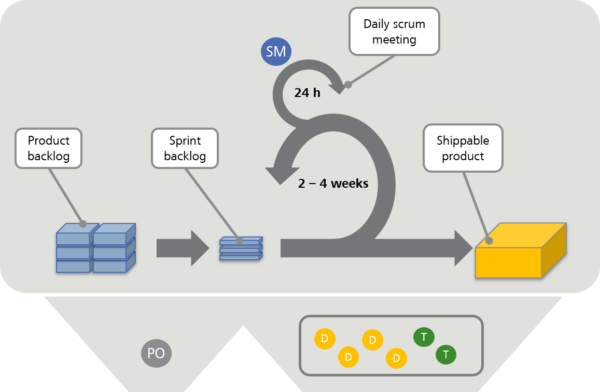
The key principles from the Agile Manifesto are:
- Individuals and interactions are more important than processes and tools.
- Working software is more important than comprehensive documentation.
- Client collaboration is more important than the original specifications.
- Responding to change is more important than following a plan.
Companies that switch to the agile method of development have a competitive advantage compared to companies using traditional methods. However, transitioning the processes to development methods such as scrum—also called agile transition—presents a great challenge. Agility is not achieved by divvying the development milestones up into sprints and appointing a product owner (see Figure 1). Comprehensive changes in the organization are required to achieve an agile way of working and living.
The challenge of the agile transition becomes very clear when you look at the example of the test manager. The question: If we do not need a test manager in scrum, who assumes their responsibilities? The product owner? The scrum master? The team?
According to the Scrum Alliance, the product owner is the person responsible for developing the product accurately and on time. The product owner fills and refines the product backlog, and ensures that everybody knows what it contains and what is given which priority. Consequently, they are usually closest to the “business side” of the project. Scrum requires the development team to be a group with mixed functions—pooling all the necessary skills—that are required for the development of the product. The team organizes itself, i.e. it independently chooses the content to be implemented in the sprint and takes care of the planning, management, and implementation. The scrum master is the “pilot” guiding them through the depths of the scrum framework, helping the rest of the scrum team to comply with scrum principles. Another task of the scrum master is removing obstacles that hamper the team’s progress
Even after studying the scrum roles, we do not know who assumes the test manager’s responsibilities, or how they are allocated. To answer these questions, we must first determine the test manager’s responsibilities in the traditional testing and quality assurance process. According to the International Software Testing Qualifications Board (ISTQB), the certification board for testers, the test manager’s role and responsibilities include more than just supervising the test project. They manage the testing department or the test team, and thus, the resources for the tests. They prepare reports; escalate to development, technical department and project management; assess test projects; ensure compliance with the company’s quality processes; procure the testing tools for the organization; and review the test plans and the test cases.
The responsibilities can be allocated to two fields: strategic and operative (see Figure 2). The operative level includes the planning and conceptual design of the test cases and tests, monitoring the execution of the tests, and the communication within the project. The strategic level includes the quality management tasks.
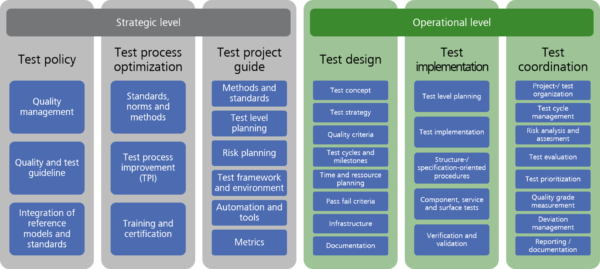
The operative responsibilities cannot be assumed by the scrum master or the product owner. The product owner does not get involved in the implementation, nor the scrum master in the development. In agile development, the testing tasks are assumed by the team. Following the definition and allocation of the test manager’s responsibilities, we can examine how they can be integrated into the agile process. However, there is a problem: It is not possible to allocate them to a specific person because within the scrum framework, all tasks are distributed across the agile team.
The solution to the problem lies within the scrum framework itself. It provides a comprehensive package of tools and artifacts that can be matched with the test manager’s responsibilities. We did a complete agile transition of the responsibilities in our scrum teams, and we found that scrum provides a tool or artifact for every one of the test manager’s responsibilities.
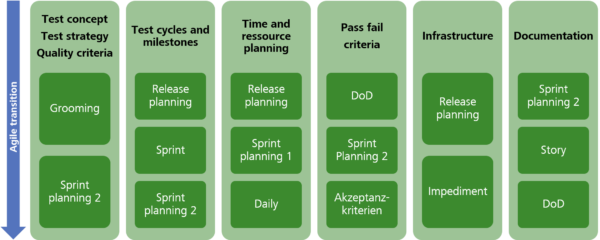
For example, the test strategy and the paramount quality characteristics are considered during the planning of the sprint and the backlog grooming. The pass-fail criteria, i.e. the criteria that determine whether a sprint has been successful or the test has been completed, are defined in the definition of done (see Figure 3).
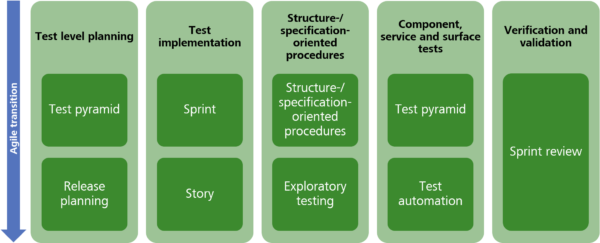
In the sprint review, the implementation of the specifications is verified and validated (see Figure 4).
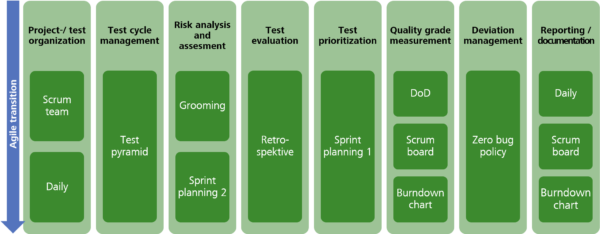
In addition, the stories and their representation on the scrum board and in the backlogs facilitate documentation of the progress and the assessment of the quality level (see Figure 3).
Accordingly, there is an agile tool or artifact for each of the test manager’s responsibilities. And thus, complete agile transition of the test manager’s responsibilities is achieved. Provided that the scrum team has the testing know-how required for the implementation of the upcoming development and testing tasks, small projects do not require a test manager. If the know-how is not yet given, the team has to be coached accordingly.
In the next part, we will examine who can assume the responsibilities on the strategic level, and what happens in projects where several scrum teams work on the same product together.